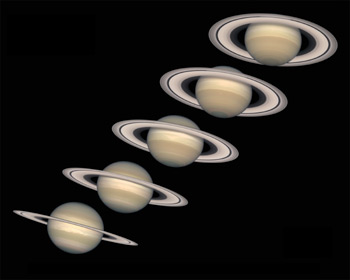
Caption: Saturn as seen from the perspective of Earth over the time period 1996--2000. Time increases going from lower left to upper right.
Features:
- The water ice fragments
(ranging in size from ∼ 1 cm to ∼ 10 m:
see Wikipedia: Rings of
Saturn: Physical characteristics)
that make up
Saturn's rings
orbit in the
plane
of Saturn's equator.
Saturn's equator
and the coplanar
Saturn's rings
have a tilt of 26.73° to relative to
the Saturn's orbital plane which
inclined relative to the
ecliptic plane
by only 2.485°.
- The Saturnian equator
and Saturn's rings
and their perpendicular
the
Saturnian rotational axis
probably have an
axial precession
(relative to the observable universe).
However, it is probably much slower than
the Earth's axial precession
since Saturn
has much more angular momentum
than the Earth, and so
its orientation
(relative to the observable universe)
has much stronger resistance to
gravitational perturbations.
So axial precession
of Saturn is very unnoticeable and
is NOT what we see in the image.
- As viewed from the
Solar System barycenter
(which is approximately the center of the
Sun),
Saturn's rings
will
be seen
edge-on
twice per
Saturnian year (29.4571 Jyr)
at the
Saturnian equinoxes
when
Saturnian rotational axis
is perpendicular
to the
barycenter-Saturn
line.
Recall the
Julian year = 365.25 days
exactly by definition.
- Since the
Earth is always about
1 AU from the
Solar System barycenter
and
the Saturnian mean orbital radius = 9.5826 AU,
the Earth's
perspective is approximately that
of the Solar System barycenter,
and so we see
Saturn's rings
edge-on
once or three times in a edge-on-viewing period of about a year that happens twice every
Saturnian year (29.4571 Jyr) on average at about the
Saturnian equinoxes
(see Wikipedia:
Rings of Saturn: Saturn's axial inclination).
Because of
the Saturnian orbital eccentricity = 0.0565 = 5.65 %
(and other orbital features), the
periods between
Saturnian equinoxes
are NOT equal: they are about 13.7 years and 15.7 years: these periods, of course,
add up the Saturnian year (29.4571 Jyr).
So the edge-on-viewing periods
are NOT equally spaced in time: they are
13.7 years apart and then 15.7 years apart and then ... and so on.
An edge-on-viewing period (with 3 edge-on views) occurred 1995--1996 (see Wikipedia: Rings of Saturn: Saturn's axial inclination). The lower left view of Saturn in the image probably shows Saturn shortly after the last edge-on view in 1996.
- Because Saturn's rings are very flat---ranging from ∼ 10 m to ∼ 1 km thick (see Wikipedia: Rings of Saturn: Physical characteristics)---the Saturn's rings practically vanish at an edge-on view.
- Saturn's rings are most full at about the two Saturnian solstices which happen twice a Saturnian year (29.4571 Jyr) at about midpoint times between the Saturnian equinoxes.
- For a bit of astronomy history, Galileo (1564--1642) was the first to observe Saturn's rings with his Galilean telescope in 1610, but he could NOT determine what they were---planets? appendages?---he described them sometimes as "ears". When Saturn's rings vanished in an edge-on view in 1612, Galileo commented "Has Saturn swallowed his children?" referring to the myth of the Greek god Cronus (who was syncretized to the Roman god Saturn) swollowing his children---they got out later on. For reference, see Wikipedia: Rings of Saturn: Galileo's work; Wikipedia: Galileo: Saturn and Neptune. Christiaan Huygens (1629--1695) in 1655 was the first to propse that Saturn had a planetary ring and viewing the planetary ring nearly edge-on caused the periodic disappearance of the planetary ring (see Wikipedia: Christiaan Huygens: Saturn's rings and Titan; Wikipedia: Rings of Saturn: Ring theory, observations and exploration).
- Because Saturn's rings are very flat---ranging from ∼ 10 m to ∼ 1 km thick (see Wikipedia: Rings of Saturn: Physical characteristics)---the Saturn's rings practically vanish at an edge-on view.
Download site: NASA: HST.
Image link: Itself.
Local file: local link: saturn_rings_orientation_perspective.html.
File: Saturn file: saturn_rings_orientation_perspective.html.